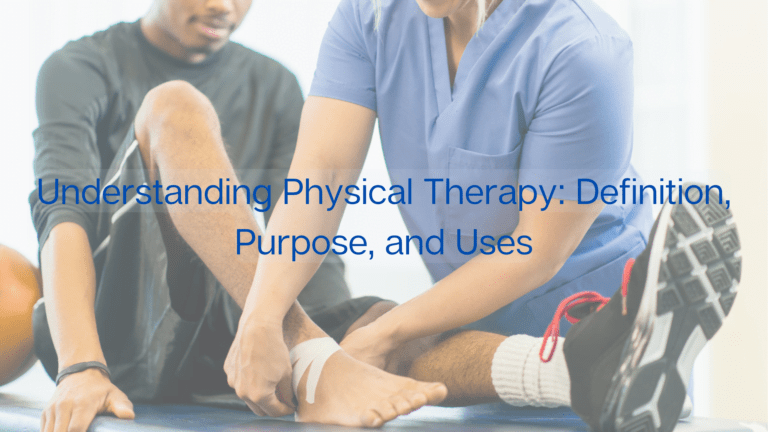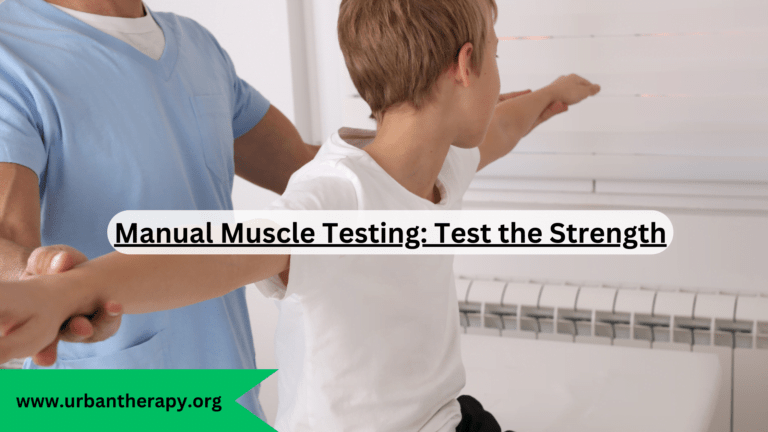Introduction
Muscle strength testing, a pivotal facet of modern healthcare, lay open a profound understanding of our physical capabilities. From the simplest gestures to the most intricate movements, our muscles orchestrate the symphony of human motion. Within this intricate symphony, an assessment of muscle strength plays a critical role, offering insights into a patient’s muscular functionality and neurologic well-being. The evaluation process goes beyond a mere surface-level analysis, delving into the depths of true weakness, imbalances, and endurance limitations. This intricate dance of muscular evaluation is conducted under various terminologies, such as motor testing, muscle strength grading, and manual muscle testing, reflecting the multifaceted nature of the assessment. Moreover, this evaluation encompasses a spectrum of methodologies, each unveiling a unique facet of muscle capabilities.
Understanding Muscle Strength Testing
Muscle strength testing stands as a pivotal cornerstone within modern healthcare, offering a structured approach to evaluating the force generated by muscles during specific actions. It serves as a dynamic gauge, allowing healthcare practitioners to quantitatively assess the muscular prowess of an individual. While muscle strength testing does include an element of measuring muscle size, it reaches far beyond this superficial dimension, offering a comprehensive insight into the functional capacity of muscles.
This evaluation serves as a potent diagnostic tool, aiding in the assessment of various musculoskeletal conditions and contributing to the formulation of targeted treatment plans. By meticulously quantifying the force that muscles can generate, healthcare professionals gain a nuanced understanding of a patient’s muscular abilities and limitations. This goes beyond a mere numeric value; it encompasses a window into the intricate interplay between muscle function, neural coordination, and overall physiological well-being.
Exploring Actual Muscle Performance
To grasp the essence of muscle strength testing, one must transcend the traditional concept of muscle size as the sole determinant of strength. This evaluation takes us deep into actual muscle performance, where the stage is set for a symphony of physiological processes. While muscle size does play a role, muscle strength testing delves into the multifaceted interactions that define our muscular capabilities.
This multidimensional perspective encompasses factors such as motor unit recruitment, neural synchronization, rate coding, and neuromuscular inhibition. Each of these elements weaves together to orchestrate the symphony of muscle performance. Muscle strength testing unveils the harmony between the nervous system and muscle fibers, shedding light on the synchronized efforts that empower us to execute precise movements, from the most delicate gestures to the most vigorous exertions.
Muscle Strength and Physical Health
Beyond the confines of individual muscle groups, muscle strength forms an integral nexus between muscular function and overall physical health. Our muscles are not solitary entities; they are intricate components of a broader physiological ensemble that dictates our ability to engage in daily activities and maintain posture. The relationship between muscle strength and physical health extends far beyond the territory of brute force; it influences our quality of life, functional independence, and resilience.
Muscle strength serves as a harbinger of vitality, influencing not only the ability to lift, push, or pull but also the grace with which we move, the stability with which we stand, and the energy with which we navigate the world. By assessing muscle strength, healthcare practitioners gain invaluable insights into a patient’s functional capacity, thus enabling the design of tailored interventions to enhance overall physical well-being.
Techniques for Muscle Strength Testing
Manual Muscle Testing (MMT)
Introduction to MMT and its Historical Development
Manual Muscle Testing (MMT) is a fundamental method employed in clinical practice to assess muscle strength, function, and overall neuromuscular health. Developed over decades, MMT has evolved into a standardized approach used by healthcare professionals worldwide. Its origins can be traced back to the mid-20th century, with notable contributions from pioneers like Florence Kendall and Henry Kendall.
Step-by-step Guide to Performing MMT
- Selecting Muscles: MMT typically involves evaluating specific muscle groups relevant to the patient’s condition. These muscles are carefully chosen based on their function and the targeted area of assessment.
- Applying Resistance: The examiner applies manual resistance against the muscle being tested, while the patient is instructed to exert force in a specific direction. This resistance can be applied in various ways, such as pushing, pulling, or holding against gravity.
- Grading Muscle Strength: MMT employs a standardized grading scale to quantify muscle strength. Commonly used scales include the Oxford scale and the Kendall scale. Each scale consists of numerical grades that correlate with the muscle’s ability to overcome resistance.
Oxford Muscle Grading
The Oxford muscle grading system, revered for its comprehensive approach, provides a nuanced framework for assessing muscle strength. Delineated across twelve grades, this system encapsulates the spectrum of muscle function with remarkable precision:
- Grade 0: No contraction observed.
- Grade 1: A flicker of contraction was detected, but no movement.
- Grade 2: Movement occurs with gravity eliminated.
- Grade 3: Muscle moves against gravity but not against resistance.
- Grade 4: Muscle demonstrates strength against moderate resistance.
- Grade 5: Full strength showcased against maximal resistance.
- Grades 4+: Muscle exhibits strength against moderate resistance and slight overcoming of additional resistance.
- Grades 5-: Muscle displays full strength against maximal resistance with slight weakness.
- Grades 5–: Slight movement against maximal resistance.
- Grade 0+: Trace of contraction perceived, but no movement.
- Grade 1-: Faint movement against gravity.
The Kendall Muscle Testing
The Kendall muscle testing system, celebrated for its pragmatic approach, empowers practitioners with a spectrum of muscle strength insights. This methodology employs a six-point scale, encapsulating the following gradations:
- Strong: Complete range of motion against gravity and maximal resistance.
- Good: Complete range of motion against gravity and moderate resistance.
- Fair: Complete range of motion against gravity, but not against resistance.
- Poor: Muscle contraction only when gravity is eliminated.
- Trace: Minute muscle contraction detected, but no joint movement.
- Zero: No muscle contraction observed.

Manual Muscle Testing Chart
The Manual Muscle Testing (MMT) chart, a visual aid of paramount significance, facilitates rapid and accurate muscle strength assessment. This chart encompasses an array of muscle groups and associated grading levels, fostering a holistic understanding of muscular capabilities. It serves as an indispensable reference for clinicians, expediting the assessment process and enhancing the consistency and objectivity of muscle strength evaluations.
MRC Grading of Muscle Strength
The Medical Research Council (MRC) grading system, renowned for its clinical utility, offers a straightforward yet insightful approach to muscle strength assessment. This six-point scale appraises muscle function across a spectrum:
- Grade 0: No muscular contraction detected.
- Grade 1: Flicker of contraction observable, but no movement.
- Grade 2: Movement transpires when gravity is eliminated.
- Grade 3: Muscle achieves movement against gravity but not against resistance.
- Grade 4: Muscle demonstrates strength against some resistance.
- Grade 5: Full muscle strength exhibited against maximal resistance.
Interpretation of MMT Grades and Their Clinical Significance
The interpretation of MMT grades provides valuable insights into a patient’s muscle function and neuromuscular integrity. Higher grades indicate greater strength, while lower grades suggest weakness. Clinicians assess the ability of muscles to generate force, and discrepancies between opposing muscle groups may indicate imbalances or dysfunction.
Application of MMT Scales and Implications in Assessments
The use of MMT scales, such as the Oxford scale and the Kendall scale, enhances the precision and consistency of muscle strength assessment. These scales provide a standardized framework for grading muscle strength, allowing for accurate comparisons across different patients and evaluators. The Oxford scale, for instance, categorizes muscle strength into six grades, ranging from zero (no contraction) to five (normal strength).
Case Studies Showcasing the Utility of MMT
- Muscle Weakness Diagnosis: MMT played a pivotal role in diagnosing a patient with suspected muscle weakness in the lower limbs. By assessing specific muscle groups using MMT, clinicians accurately identified the affected areas, aiding in targeted treatment planning.
- Paralysis Assessment: MMT was instrumental in evaluating a patient with suspected paralysis due to a neurological disorder. The systematic grading of muscle strength through MMT provided crucial information about the extent and severity of paralysis, guiding further diagnostic investigations.
Quantitative Muscle Testing (QMT)
Explanation of QMT as an Objective Method for Assessing Muscle Strength
Quantitative Muscle Testing (QMT) is a precise and objective approach to measuring muscle strength. Unlike subjective methods, QMT utilizes specialized equipment to quantify muscle force, providing numerical data for assessment.

Overview of Equipment Used in QMT
QMT employs various devices, including handheld dynamometers and computerized systems. Handheld dynamometers measure the force exerted by a muscle during maximal contraction, offering portability and ease of use. Computerized systems, on the other hand, utilize advanced technology to provide detailed force-time curves and accurate measurements.
| QMT Equipment | Description |
| Handheld | The portable device measuring the force exerted during contraction |
| Computerized | The advanced system provides detailed force-time curves |
Benefits of QMT in Research Settings, Rehabilitation Centers, and Tracking Treatment Progress
QMT has found widespread applications across diverse settings. In research, QMT allows for precise data collection, aiding scientists in studying muscle function and performance. In rehabilitation centers, QMT assists in designing tailored exercise regimens to address muscle imbalances and weaknesses. Additionally, QMT serves as a valuable tool for monitoring treatment progress and objectively assessing the effectiveness of interventions.
Comparison of QMT with Other Testing Methods
QMT offers distinct advantages over traditional methods, such as MMT. While MMT relies on subjective observations, QMT provides objective measurements that are less prone to examiner bias. QMT’s ability to generate quantitative data enables precise tracking of changes in muscle strength over time, enhancing its reliability as an assessment tool.
Functional Testing
Definition of Functional Testing and Its Integration with Muscle Strength Assessment
Functional testing assesses muscle strength within the context of real-life activities and movements. This approach evaluates the ability of muscles to perform tasks that mimic daily challenges, providing valuable insights into a patient’s functional capacity.
Detailed Description of Functional Tests
- Sit-to-Stand Test: This test assesses lower limb strength and endurance by measuring the ability to rise from a seated position to a standing position repetitively.
- Gait Analysis: Gait analysis evaluates muscle strength during walking, shedding light on abnormalities, imbalances, and compensatory mechanisms.
- Sport-Specific Movements: Functional testing includes sport-specific movements tailored to individual patients, enabling assessment of muscle strength in activities relevant to their lifestyle.
Importance of Functional Testing in Evaluating Muscle Performance
Functional testing goes beyond isolated muscle strength measurement, offering a holistic view of a patient’s physical capabilities. It reflects the integration of multiple muscle groups and their collaborative efforts during functional tasks, making it a valuable tool for assessing overall muscle performance.
Illustrative Examples of Functional Testing Protocols
- Post-Surgical Assessment: A patient recovering from knee surgery underwent functional testing, revealing deficits in muscle strength during movements like squatting and stair climbing. This information guided the design of a targeted rehabilitation plan.
- Performance Optimization: An athlete undergoing functional testing displayed superior muscle strength during sport-specific movements. This data was used to tailor a training regimen that capitalized on existing strengths and targeted areas of improvement.
Isokinetic Dynamometry
Isokinetic dynamometry involves assessing muscle strength while maintaining a constant angular velocity. This technique provides insights into muscle performance across different joint angles and velocities.
Explanation of How Isokinetic Devices Work
Isokinetic devices control the speed of movement, ensuring a consistent angular velocity throughout the muscle’s range of motion. This enables maximal muscle activation regardless of joint position, allowing for comprehensive strength evaluation.
Applications of Isokinetic Dynamometry in Rehabilitation and Research
Isokinetic dynamometry is widely used in both rehabilitation and research settings. In rehabilitation, it aids in designing targeted exercises to address muscle imbalances and weaknesses. In research, isokinetic dynamometry contributes to studying muscle function, analyzing joint stability, and investigating dynamic movements.
Case Studies Demonstrating the Use of Isokinetic Dynamometry
- Muscle Imbalance Assessment: Isokinetic dynamometry identified significant muscle imbalances in a patient with chronic lower back pain. This information guided the development of an exercise regimen focused on restoring balance and function.
- Prescription of Targeted Exercises: An individual recovering from a knee injury underwent an isokinetic dynamometry assessment, which revealed specific angles of weakness. The data informed the selection of exercises that targeted these weak points, enhancing the effectiveness of rehabilitation.
Clinical Significance and Applications
The clinical significance of muscle strength testing extends far beyond the confines of the examination room. Within each application lies a testament to its transformative potential in shaping diagnoses, interventions, and ultimately, the lives of patients. In this section, we delve into the diverse domains where muscle strength testing plays a pivotal role, unraveling its impact on musculoskeletal health, neurology, rehabilitation, geriatrics, and pediatrics.
Orthopedics and Sports Medicine: Precision in Performance
Diagnosing Musculoskeletal Injuries
Muscle strength testing emerges as a beacon in the domain of orthopedics and sports medicine. It serves as a diagnostic compass, illuminating the intricacies of musculoskeletal injuries that athletes and individuals encounter. By quantifying muscle strength, healthcare practitioners gain insights into the extent of damage—whether it’s a sprain, strain, or tear. This assessment becomes a cornerstone in the diagnostic puzzle, guiding treatment strategies and facilitating timely recoveries.
Optimizing Rehabilitation and Performance
The role of muscle strength testing transcends injury management—it extends to the world of performance optimization. For athletes, muscle strength testing informs the design of targeted rehabilitation programs that not only aid in recovery but also prevent future injuries. It becomes a blueprint for achieving optimal athletic performance by identifying weak links and addressing imbalances. This precision-driven approach transforms muscle strength testing into a gateway toward peak physical potential.
Neurology
Tracking Neurodegenerative Diseases
Within the field of neurology, muscle strength testing assumes a profound significance in tracking the trajectory of neurodegenerative diseases. Conditions such as Parkinson’s and ALS intricately intertwine with muscle function, and muscle strength testing becomes a tangible marker of disease progression. By quantifying strength, healthcare professionals gain valuable insights into the impact of these conditions on the neuromuscular system.
Early Detection and Treatment Planning
The early stages of neurodegenerative diseases often manifest subtly, making early detection paramount for effective intervention. Muscle strength testing serves as a sentinel, offering an objective measure to detect even the slightest changes in muscle function. This early detection paves the way for proactive treatment planning, enabling healthcare providers to tailor interventions and strategies that maximize patient outcomes and quality of life.
Physical Therapy and Rehabilitation
Developing Individualized Treatment Plans
Muscle strength testing finds its haven within physical therapy and rehabilitation. It becomes a cornerstone in the development of individualized treatment plans, providing a comprehensive view of a patient’s muscular capabilities and limitations. This insight enables healthcare practitioners to craft targeted interventions that address specific weaknesses, restore function, and expedite the recovery process.
Evidencing Successful Rehabilitation Outcomes
Through compelling case studies, the impact of muscle strength testing on rehabilitation outcomes comes to life. These stories showcase how precise muscle strength assessment translates into successful recoveries. Whether it’s post-surgery rehabilitation or recovery from an injury, the integration of muscle strength testing ensures that each step of the journey is backed by data-driven decisions and tailored therapies.
Geriatrics and Aging Population
Assessing Sarcopenia and Age-Related Muscle Loss
Muscle strength testing emerges as a guiding light within geriatrics, offering insights into the complex terrain of aging-related muscle loss. As individuals age, muscle mass and strength naturally decline, leading to conditions like sarcopenia. Muscle strength testing becomes a diagnostic tool, quantifying the extent of muscle decline and informing targeted interventions to mitigate its impact.
Enhancing Mobility and Quality of Life
Maintaining muscle strength holds the key to enhanced mobility and quality of life among the elderly population. Muscle strength testing becomes a metric of vitality, guiding interventions that preserve functional independence and promote active aging. By addressing age-related muscle loss through tailored exercises and therapies, healthcare professionals empower the elderly to navigate life’s journey with vigor and resilience.
Pediatrics and Developmental Disorders
Diagnosing and Managing Neuromuscular Disorders
Within pediatrics, muscle strength testing assumes a critical role in diagnosing and managing neuromuscular disorders that affect children. Whether it’s congenital conditions, neuromuscular diseases, or developmental disorders, muscle strength testing becomes a diagnostic tool that unravels the intricacies of muscular function. This insight forms the foundation for precise treatment planning.
Early Intervention and Tailored Therapies
Muscle strength testing guides the path of early intervention, allowing healthcare professionals to initiate therapies that align with a child’s unique needs. By quantifying muscle strength, healthcare providers create tailored strategies that promote muscular development, enhance motor skills, and nurture growth. This approach transforms muscle strength testing into a compass that guides the journeys of young patients toward optimal development.
Future Implications and Research
Muscle strength testing stands on the threshold of a transformative era, where ongoing research and technological advancements are poised to reshape its methodologies, applications, and impact. In this section, we embark on a detailed exploration of the future implications of muscle strength testing, delving into the exciting avenues of research, the potential applications that lie beyond the horizon, and the indispensable role of interdisciplinary collaboration in propelling this field into uncharted territories.
Ongoing Research
Evolving Methodologies for Enhanced Precision
The pursuit of precision drives ongoing research endeavors in muscle strength testing. Scholars and researchers are meticulously dissecting existing methodologies, scrutinizing grading systems, and investigating measurement techniques. By unraveling the subtleties that underlie muscle strength assessments, these studies aim to fine-tune the accuracy and clinical relevance of the data generated. Such refinements promise to empower healthcare practitioners with an even deeper understanding of muscular functionality.
The Promise of Innovative Tools and Technologies
The marriage of muscle strength testing with cutting-edge technology is a beacon of promise. Ongoing studies delve into the potential of wearable devices, sensor technologies, and artificial intelligence algorithms. These innovations hold the potential to revolutionize muscle strength assessment by providing real-time, objective data and insights. From smart garments that monitor muscle performance to AI-powered systems that analyze intricate strength patterns, the landscape of muscle strength testing is poised for a technological renaissance.
Future Applications
Personalized Medicine: Tailoring Interventions to Individual Strength Profiles
The fusion of muscle strength testing with personalized medicine ushers in a new era of tailored interventions. Imagine a scenario where a patient’s unique muscular capabilities and limitations form the cornerstone of treatment planning. Muscle strength assessment serves as the key to unlocking these individual strength profiles, enabling healthcare professionals to craft interventions that align precisely with each patient’s needs. This personalized approach promises to optimize treatment outcomes and enhance patient well-being.
Telehealth: Redefining Accessibility and Convenience
Telehealth is a transformative force that transcends geographical boundaries. Muscle strength testing, with its potential for remote assessments and data transmission, is poised to reshape the landscape of virtual healthcare. Patients in remote areas can now undergo comprehensive muscle strength evaluations without the constraints of physical proximity. The marriage of telehealth and muscle strength testing offers unparalleled accessibility, convenience, and patient-centric care.
Interdisciplinary Collaboration
Engineers, Clinicians, and Researchers
At the heart of the future of muscle strength testing lies the synergy of interdisciplinary collaboration. Engineers, clinicians, and researchers form a triumvirate of expertise that fuels innovation. Engineers bring technological prowess, crafting novel devices and sensor systems. Clinicians contribute real-world insights, ensuring that advancements align with practical clinical needs. Researchers delve into uncharted territories, exploring unexplored facets of muscular function. This collective effort ignites a chain reaction of innovation, pushing the boundaries of muscle strength testing.
The Alchemy of Collaborative Creativity
Interdisciplinary collaboration is more than a mere partnership; it is an alchemical process where diverse perspectives blend to create transformative outcomes. The convergence of engineering acumen, clinical experience, and research curiosity yields breakthroughs that redefine the practice of muscle strength testing. This collaborative synergy challenges preconceptions sparks novel ideas, and opens doors to hitherto unimagined possibilities.
Final Words
In the culmination of our journey through muscle strength testing, we reflect upon the insights and wisdom that have unfolded. This comprehensive guide has unfurled a rich tapestry of knowledge, showcasing the multifaceted techniques that illuminate the intricacies of muscular function. As we conclude, we emphasize the transformative role of muscle strength testing in modern healthcare and extend a resounding call to action for healthcare professionals to integrate this indispensable tool into their practice.
Key Takeaways
Our exploration has yielded key takeaways that enrich our understanding of muscle strength testing. From the historical roots of manual muscle testing to the precision of quantitative assessments and dynamic functional testing, we’ve uncovered diverse techniques that underpin accurate diagnoses and personalized interventions. Each technique contributes a unique perspective, weaving a holistic narrative of muscular health and performance.
The Crucial Role of Muscle Strength Testing
Muscle strength testing emerges as a pivotal cornerstone within the landscape of modern healthcare. It bridges the gap between subjectivity and objectivity, providing tangible data-driven insights that guide clinical decisions. This tool empowers healthcare professionals to craft tailored interventions, optimize treatment strategies, and track progress with unparalleled precision. The result is enhanced patient outcomes, informed by a deeper understanding of the intricate interplay of muscles and motion.
As we step forward, armed with the insights of this guide, we usher in a new era in healthcare—where muscle strength testing is not just a diagnostic tool, but a catalyst for clinical excellence. Let us unite theory with practice, fuse innovation with tradition, and align precision with compassion. By doing so, we forge a future where muscle strength testing takes its rightful place as an essential pillar of medical practice, guiding us toward a healthier, more empowered, and enlightened world.
FAQs
[faq question=”Q: What is Manual Muscle Testing?”]Manual Muscle Testing (MMT) is a clinical technique used to assess muscle strength and function. It involves applying resistance to specific muscles to determine their strength and grade the muscle’s performance. MMT plays a crucial role in evaluating neuromuscular conditions and guiding treatment plans in comprehensive patient care.”[/faq]
[faq question=”Q: How is Manual Muscle Testing performed?”]During Manual Muscle Testing, a healthcare professional applies resistance against a patient’s muscle movement. The patient is asked to perform a specific action while the examiner assesses the muscle’s response. The examiner grades the muscle strength based on standardized scales, providing valuable insights into the patient’s muscle function and overall health.”[/faq]
[faq question=”Q: What are the benefits of Manual Muscle Testing in patient care?”]Manual Muscle Testing offers several benefits in patient care. It helps identify muscle weaknesses, imbalances, and functional limitations. By assessing muscle performance, healthcare providers can tailor treatment plans, track progress, and make informed decisions to enhance patients’ overall well-being and quality of life.”[/faq]
[faq question=”Q: Can Manual Muscle Testing diagnose neuromuscular conditions?”]Yes, Manual Muscle Testing plays a crucial role in diagnosing neuromuscular conditions. It provides valuable information about muscle strength and function, aiding in the identification of muscle disorders, nerve injuries, and other neuromuscular abnormalities. The results of MMT contribute to accurate diagnoses and effective treatment strategies.”[/faq]
[faq question=”Q: How does Manual Muscle Testing guide treatment plans?”]Manual Muscle Testing guides treatment plans by helping healthcare professionals understand a patient’s muscle strength and limitations. Based on MMT results, tailored interventions, exercises, and therapies can be designed to address specific muscle weaknesses and imbalances. This personalized approach optimizes patient care and enhances treatment outcomes.”[/faq]
[faq question=”Q: What are the different grading scales used in Manual Muscle Testing?”]Manual Muscle Testing involves various grading scales, such as the Oxford scale and the Kendall scale. These scales categorize muscle strength levels from 0 to 5, providing a standardized framework for assessing and communicating muscle performance. Each grade corresponds to specific muscle function and clinical implications.”[/faq]
[faq question=”Q: Is Manual Muscle Testing used in physical therapy?”]Yes, Manual Muscle Testing is commonly used in physical therapy. Physical therapists employ MMT to evaluate muscle function, design personalized rehabilitation programs, track progress, and make necessary adjustments to optimize the effectiveness of therapy. It is a fundamental tool in the comprehensive patient care provided by physical therapy professionals.”[/faq]
[faq question=”Q: Can Manual Muscle Testing help prevent muscle injuries?”]Yes, Manual Muscle Testing can contribute to preventing muscle injuries. By identifying muscle weaknesses and imbalances, healthcare providers can create targeted exercise regimens and interventions that address these vulnerabilities. Strengthening weak muscles and promoting balanced muscle function can reduce the risk of injuries and improve overall musculoskeletal health.”[/faq]
[faq question=”Q: What role does Manual Muscle Testing play in post-surgical recovery?”]Manual Muscle Testing is essential in post-surgical recovery. It helps monitor muscle strength changes after surgery, track rehabilitation progress, and ensure proper healing. By assessing muscle function, healthcare professionals can adapt treatment plans, guide exercises, and promote safe and effective recovery following surgical procedures.”[/faq]
[faq question=”Q: Is Manual Muscle Testing a reliable diagnostic tool?”]Yes, Manual Muscle Testing is considered a reliable diagnostic tool in healthcare. It provides objective and quantifiable data about muscle strength and function, allowing healthcare providers to make accurate diagnoses and informed decisions. When used alongside other clinical assessments and tests, Manual Muscle Testing enhances diagnostic accuracy and comprehensive patient care.”[/faq]

Muskan Thakur is a skilled physical therapist based in Los Angeles, USA. She completed her Bachelor of Physical Therapy (BPT) from Delhi University in 2010. Ms. Thakur furthered her studies by completing a clinical residency program focused on orthopedic physical therapy at Duke University in the United States in 2012. She then attained her Master’s in Public Health (MPH) from the Institute of Public Health in Delhi in 2015. With over 10 years of experience, Ms. Thakur employs a holistic approach combining manual therapy, therapeutic exercise, education, and lifestyle modifications to treat neurological, orthopedic, and musculoskeletal conditions.





